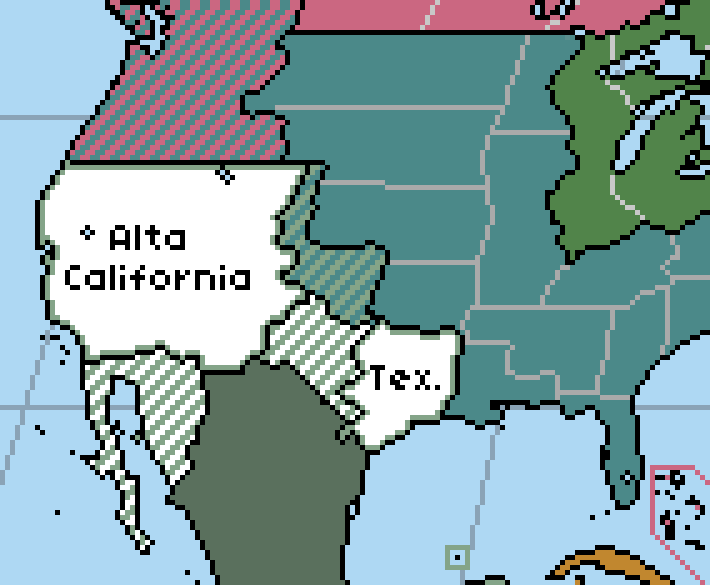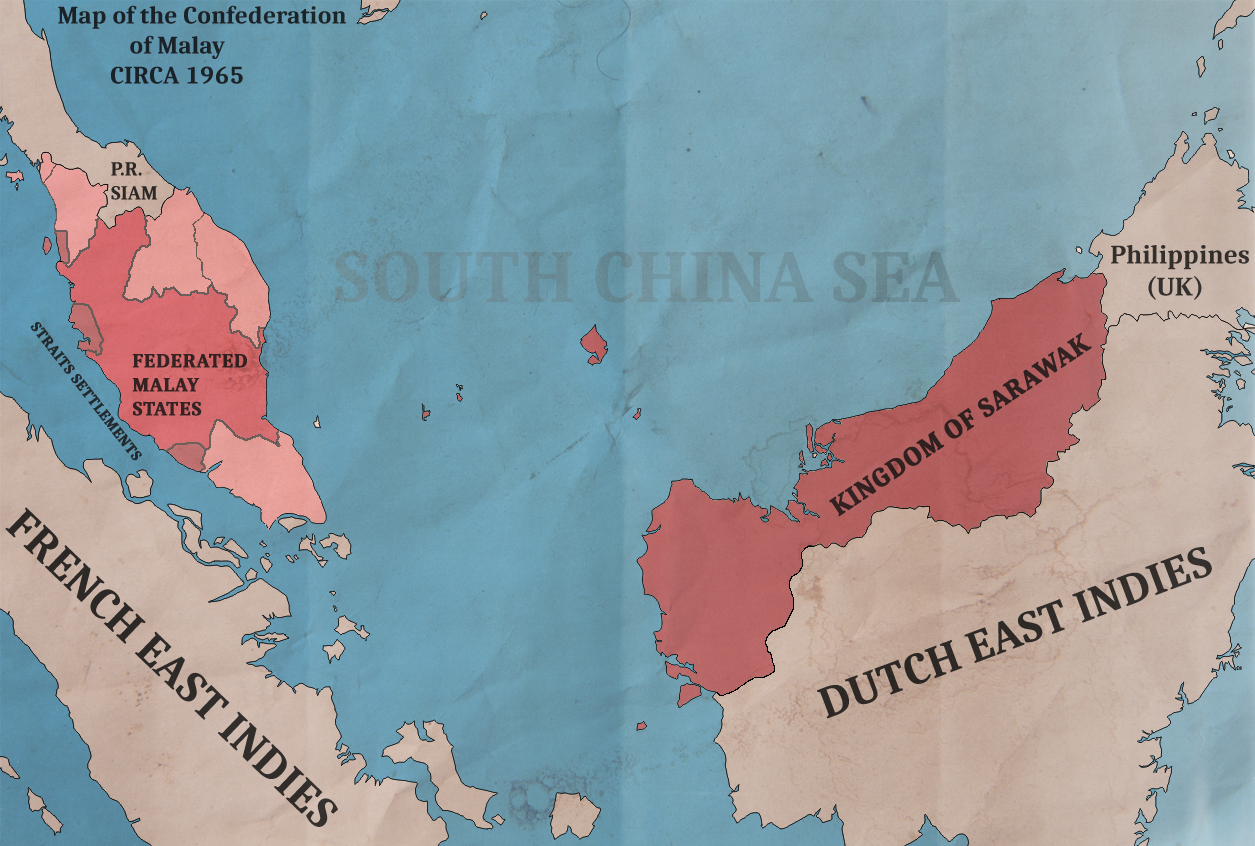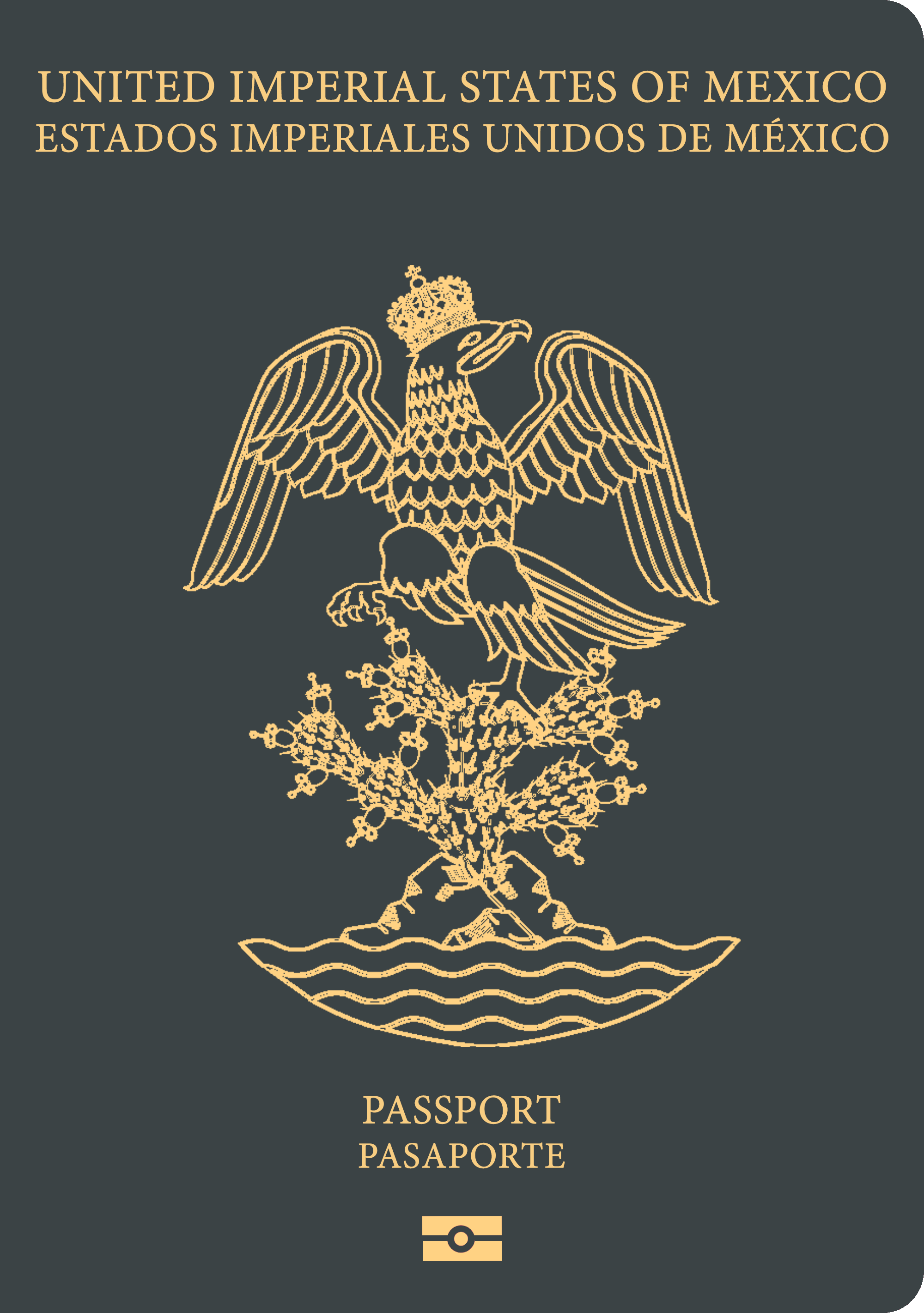History of Mexico
KitFisto1997
Banned
The United Imperial States of Mexico is a federation of 22 states under a semi-constitutional monarchy. With a population of approximately 130 million people it ranks as the most populous nations on the North American continent, being bordered by California and Texas in the north and the Caribbean Commonwealth via the Yucatan Peninsula and Gran Colombia in the south.
Early History and Independence (1519-1830)
Prior to colonisation by the Hapsburg Spanish, the area that compromises Mexico was once ruled by various tribes that came and went for a myriad of reasons. But with the arrival of the Spaniards in 1519 – commanded by one Hernán Cortés – the Aztec capital of Tenochtitlan was subsequently razed to the ground; Emperor Montezuma was murdered and the rest of the populace was later enslaved and forcibly converted to Christianity. The Spanish Viceroyalty of New Spain later thrived after the discovery of resources such as silver as mines began to open in the region surrounding Guanajuato in the 17th century. With the importation of numerous Spanish, Portuguese and other Iberian ethnic groups, the population of natives were decimated by the introduction of settlers and the various diseases that they brought with them – namely that of smallpox and TB.
Because of the breeding between the surviving natives and the newly imported Europeans, various distinct ethnic groups and creole languages began to develop out of this cross-cultural mix that lead to a distinct class system developing with pure blooded Europeans on the top of the scale followed by those of mixed race then with pure natives and African slaves on the bottom. Elements of this class system have survived through the Mexican aristocracy but peerages being given to non-Criollo (i.e. someone with full European ancestry on both the maternal and paternal sides of the family) aren’t unheard of in the last two centuries as the heavily Roman Catholic, socially conservative society became influenced by their liberal neighbours to the north.
The current incarnation of the Mexican government came to be after the events that triggered the collapse of the Spanish Overseas Empire – namely overextension and the various political and social conflicts back home cause by the Liberal Revolutions of 1790-1848. The rebellious factions in the New Spanish government took the chance by declaring independence in 1810, with the rebellion lasting until 1821 with General (later Emperor) Agustín de Iturbide’s forces breaching the walls of Mexico City. Iturbide later crowned himself Emperor of Mexico in 1822, ruling until his death in 1843.
Dismemberment of Mexico (1830-1840)
The first few decades of independence for the Mexican Empire were marred with political violence, corruption and economic instability. Emperor Augustin was almost overthrown 8 months into his rule, but was eventually able to launch a counter-coup that eventually led to the conservative Antonio López de Santa Anna being appointed to the office of Caudillo (a political position that combined that of the Head of the Armed Forces and the Head of Government) in 1824. Santa Anna proved to be loyal to the Emperor’s cause and purged many liberal leaders in the puppet Mexican Congress. Santa Anna was also the man who signed off the agreement that led to many American Southerners settling in what is now the Republic of Texas. This would later backfire as many Texans began to lobby for an independent state with ascension to the United States as a possible end goal. On the 2nd of March, 1836, the Republic of Texas declared independence, followed by an immediate declaration of war by the United States of America and British Empire (although the intervention of the latter was regarding the status of California and Oregon).
The war was an immediate success for both the Texan and Californian rebels and the two states gained independence in 1838 after the Treaty of Velasco. A captured Santa Anna agreed to the terms and recognised the two rebel states within the American and British spheres of influence respectively. Because of such a humiliating blow, the remaining Liberal factions that weren’t purged by Santa Anna began to revolt, presenting a list of demands to Emperor Agustin. What then became known as the ‘Three Demands’ were presented and ratified by a humiliated Emperor.
Industrialisation, Economic Boom and the Cold War (1840-1960)
After the death of Emperor Agustín de Iturbide in 1843 and the ascension of his son, Agustín II of Mexico (aka Agustín Jerónimo de Iturbide y Huarte) that same year, the Mexican economy was starting to recover after years of instability and societal unrest. Industrialisation of major port cities such as Veracruz and the capital of Mexico City began in earnest with many American, British and French companies investing into the new factories that have since been replaced with the glistening headquarters of the various foreign and native megacorporations.
Mexican society began to progress further as the nation began to enact French-style reforms that kept the clergy in a powerful position in the government, whilst also maintaining a balance between the aristocracy and the regular landed gentry. Even today, the Mexican people are proud of their links to the Vatican in the Papal States which is a unifying force that has somehow managed to keep the influence of the multinationals, narcos and corrupt officials at bay. The rise of the militant Catholic Church during the early years of the Cold War has led to a sense of unity amongst the nations that profess to have a thin line between Church and State, but even the most well-meaning cardinal knows when to speak his mind in the matters of the state.
Emperor Agustín II later proved to have aided the Mexican state out of the trials of the 1830’s and into secondary power status among the North American nations. By the time of his death in 1872 and the ascension of his son Agustín III (aka Agustín de Iturbide y Green), Mexico was a well-developed state with a nominal amount of corruption, but certainly well on the way to greatness as voting reforms and the end of slavery in the final years of Agustín II’s reign had started a Golden Age for the Mexican people. The Industrial Revolution eventually spread further into Mexico, allowing the nation a form of self-sufficiency in some areas while trading with both the nascent Caribbean Federation, California, Texas and the United States.
The beginning of the 20th century was also a time of progression with women’s suffrage being enabled in 1915 alongside the end of mandatory conscription, seeing that the Mexican nation had no threatening neighbours. The outbreak of the Balkan Wars did lead to Mexican military advisors being sent to Anatolia for observation, but barring the experience gained from the conflict with regards to the end of trench warfare and the rise of mobile warfare, Mexico hadn’t participated in a major conflict for almost a century. With economic growth at an all-time high (barring the slight hiccup that was the Great Depression, as the crash didn’t affect the Imperial States as much as it did to their northern neighbours) and the successful handling of the refugee crisis that stemmed from the Californian Revolution, the Empire seemed to be at an all-time high. But the aftermath of Agustín III’s death in 1936 and the ascension of his son, Carlos I (Carlos de Iturbide) was when the Golden Age came to an end, leading to a 40-year period of instability with the collapse of the economy, the rise of the narcos and the stranglehold that multinationals held over both Mexico and the wider Latin American region up until the early 2000’s.
History of Mexico (1519-1960). Encyclopaedia Britannica Online.

Map of the Dismemberment of Mexico, circa 1838.
Early History and Independence (1519-1830)
Prior to colonisation by the Hapsburg Spanish, the area that compromises Mexico was once ruled by various tribes that came and went for a myriad of reasons. But with the arrival of the Spaniards in 1519 – commanded by one Hernán Cortés – the Aztec capital of Tenochtitlan was subsequently razed to the ground; Emperor Montezuma was murdered and the rest of the populace was later enslaved and forcibly converted to Christianity. The Spanish Viceroyalty of New Spain later thrived after the discovery of resources such as silver as mines began to open in the region surrounding Guanajuato in the 17th century. With the importation of numerous Spanish, Portuguese and other Iberian ethnic groups, the population of natives were decimated by the introduction of settlers and the various diseases that they brought with them – namely that of smallpox and TB.
Because of the breeding between the surviving natives and the newly imported Europeans, various distinct ethnic groups and creole languages began to develop out of this cross-cultural mix that lead to a distinct class system developing with pure blooded Europeans on the top of the scale followed by those of mixed race then with pure natives and African slaves on the bottom. Elements of this class system have survived through the Mexican aristocracy but peerages being given to non-Criollo (i.e. someone with full European ancestry on both the maternal and paternal sides of the family) aren’t unheard of in the last two centuries as the heavily Roman Catholic, socially conservative society became influenced by their liberal neighbours to the north.
The current incarnation of the Mexican government came to be after the events that triggered the collapse of the Spanish Overseas Empire – namely overextension and the various political and social conflicts back home cause by the Liberal Revolutions of 1790-1848. The rebellious factions in the New Spanish government took the chance by declaring independence in 1810, with the rebellion lasting until 1821 with General (later Emperor) Agustín de Iturbide’s forces breaching the walls of Mexico City. Iturbide later crowned himself Emperor of Mexico in 1822, ruling until his death in 1843.
Dismemberment of Mexico (1830-1840)
The first few decades of independence for the Mexican Empire were marred with political violence, corruption and economic instability. Emperor Augustin was almost overthrown 8 months into his rule, but was eventually able to launch a counter-coup that eventually led to the conservative Antonio López de Santa Anna being appointed to the office of Caudillo (a political position that combined that of the Head of the Armed Forces and the Head of Government) in 1824. Santa Anna proved to be loyal to the Emperor’s cause and purged many liberal leaders in the puppet Mexican Congress. Santa Anna was also the man who signed off the agreement that led to many American Southerners settling in what is now the Republic of Texas. This would later backfire as many Texans began to lobby for an independent state with ascension to the United States as a possible end goal. On the 2nd of March, 1836, the Republic of Texas declared independence, followed by an immediate declaration of war by the United States of America and British Empire (although the intervention of the latter was regarding the status of California and Oregon).
The war was an immediate success for both the Texan and Californian rebels and the two states gained independence in 1838 after the Treaty of Velasco. A captured Santa Anna agreed to the terms and recognised the two rebel states within the American and British spheres of influence respectively. Because of such a humiliating blow, the remaining Liberal factions that weren’t purged by Santa Anna began to revolt, presenting a list of demands to Emperor Agustin. What then became known as the ‘Three Demands’ were presented and ratified by a humiliated Emperor.
- Santa Anna is to be imprisoned and fair elections are to be held. Voting rights are to be extended to the male landed gentry of all classes except for slaves, women and those who do not own property.
- Emperor Augustin is to give up a portion of his powers to a fully intendent Congress that will handle all affairs in the state. The Emperor can give opinions on matters of government but is only allowed to partake in affairs only in certain, dire situations.
- The Mexican Army is forever banned from influencing politics unless the entire Congress is incapacitated to the point where martial law must be declared and the Constitution suspended.
Industrialisation, Economic Boom and the Cold War (1840-1960)
After the death of Emperor Agustín de Iturbide in 1843 and the ascension of his son, Agustín II of Mexico (aka Agustín Jerónimo de Iturbide y Huarte) that same year, the Mexican economy was starting to recover after years of instability and societal unrest. Industrialisation of major port cities such as Veracruz and the capital of Mexico City began in earnest with many American, British and French companies investing into the new factories that have since been replaced with the glistening headquarters of the various foreign and native megacorporations.
Mexican society began to progress further as the nation began to enact French-style reforms that kept the clergy in a powerful position in the government, whilst also maintaining a balance between the aristocracy and the regular landed gentry. Even today, the Mexican people are proud of their links to the Vatican in the Papal States which is a unifying force that has somehow managed to keep the influence of the multinationals, narcos and corrupt officials at bay. The rise of the militant Catholic Church during the early years of the Cold War has led to a sense of unity amongst the nations that profess to have a thin line between Church and State, but even the most well-meaning cardinal knows when to speak his mind in the matters of the state.
Emperor Agustín II later proved to have aided the Mexican state out of the trials of the 1830’s and into secondary power status among the North American nations. By the time of his death in 1872 and the ascension of his son Agustín III (aka Agustín de Iturbide y Green), Mexico was a well-developed state with a nominal amount of corruption, but certainly well on the way to greatness as voting reforms and the end of slavery in the final years of Agustín II’s reign had started a Golden Age for the Mexican people. The Industrial Revolution eventually spread further into Mexico, allowing the nation a form of self-sufficiency in some areas while trading with both the nascent Caribbean Federation, California, Texas and the United States.
The beginning of the 20th century was also a time of progression with women’s suffrage being enabled in 1915 alongside the end of mandatory conscription, seeing that the Mexican nation had no threatening neighbours. The outbreak of the Balkan Wars did lead to Mexican military advisors being sent to Anatolia for observation, but barring the experience gained from the conflict with regards to the end of trench warfare and the rise of mobile warfare, Mexico hadn’t participated in a major conflict for almost a century. With economic growth at an all-time high (barring the slight hiccup that was the Great Depression, as the crash didn’t affect the Imperial States as much as it did to their northern neighbours) and the successful handling of the refugee crisis that stemmed from the Californian Revolution, the Empire seemed to be at an all-time high. But the aftermath of Agustín III’s death in 1936 and the ascension of his son, Carlos I (Carlos de Iturbide) was when the Golden Age came to an end, leading to a 40-year period of instability with the collapse of the economy, the rise of the narcos and the stranglehold that multinationals held over both Mexico and the wider Latin American region up until the early 2000’s.
History of Mexico (1519-1960). Encyclopaedia Britannica Online.

Map of the Dismemberment of Mexico, circa 1838.
Last edited:

